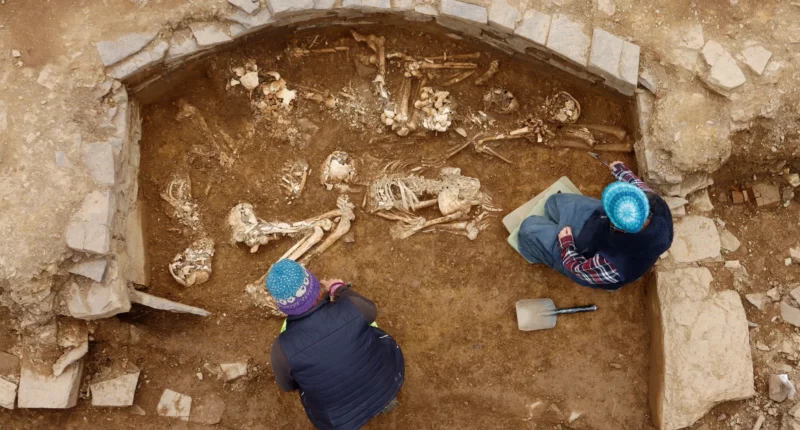National Museums Scotland disclosed the remarkable unearthing of an ancient tomb, a rare relic from 5,000 years ago, on one of Scotland’s Orkney Islands, detailed in a recent statement.
The excavation at Holm, East Mainland, Orkney, exposed a stone structure accessible via a 23-foot-long passage, along with remnants of a cairn—stones stacked atop the tomb—a feat considered the pinnacle of Neolithic engineering in Northern Britain, as per the statement.
Within one of the six smaller side cells surrounding a large stone chamber, archaeologists discovered fourteen well-preserved skeletons of men, women, and children, alongside other human remains. This tomb represents a remarkable feat of Neolithic architectural prowess, as noted by Hugo Anderson-Whymark, co-director of the excavation and senior curator of prehistory (Neolithic) at National Museums Scotland.
Among the findings, two skeletons were positioned in a near-embrace, with two children placed over their heads. The exact relationship between these individuals remains a mystery, awaiting further analysis.

Vicki Cummings, co-director of the excavation and head of the School of History, Archaeology, and Religion at Cardiff University, marveled at the exceptional preservation of these human remains, considering much of the stone was removed for construction purposes over time.
The rarity of such tomb deposits, even within well-preserved chambered tombs, offers an extraordinary opportunity to glean fresh insights into the lives of these ancient peoples, Cummings added.
Only a dozen similar tombs, known as Maes Howe-type passage graves, have been documented in Orkney. Most of these are visible in the landscape, unlike this recent discovery, which remained buried underground.
Despite its substantial destruction in the late 18th or early 19th century for constructing a farmhouse, rudimentary excavations in 1896 revealed eight skeletons, leading local antiquary James Walls Cursiter to theorize its origins as a ruined tomb.
Archived papers from Cursiter’s private collection contained invaluable clues that guided archaeologists to conduct a geophysical survey, setting the groundwork for this monumental excavation.
Reflecting on the discovery, Anderson-Whymark expressed surprise at finding such a significant structure hidden beneath what is now a serene grassy field. While the surface offers no hint of its existence, the tomb stands as a testament to an era of remarkable human ingenuity, preserved just enough for present-day exploration.





